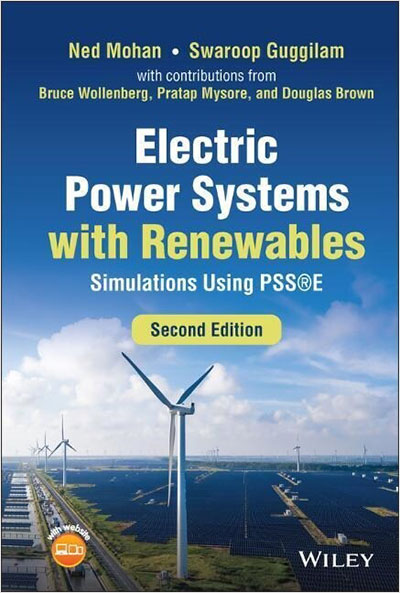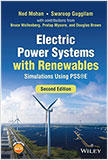
Electric Power Systems with Renewables
Concise, balanced, and fundamentals-based resource providing coverage of power system operation and planning, including simulations using PSS®E software
Electric Power Systems with Renewables provides a comprehensive treatment of various topics related to power systems with an emphasis on renewable energy integration into power systems. The updated use cases and methods in the book build upon the climate change science and renewables currently being integrated with the grid and the ability to manage resilience for electrifying transportation and related power systems as societies identify more ways to move towards a carbon-free future.
Simulation examples and software support are provided by integrating the educational version of PSS®E. The newly revised edition includes new topics on the intelligent use of PSS®E simulation software, presents a short introduction to Python (a widely used software in the power industry), and provides new examples and back-of-the-chapter homework problems to further aid in information retention.
Written by two highly qualified authors with significant experience in the field, Electric Power Systems with Renewables also contains information on:
Electric energy and the environment, covering hydro power, fossil-fuel based power plants, nuclear power, renewable energy, and distributed generation (DG)
Power flow in power system networks covers basic power flow equations, the Newton-Raphson procedure, sensitivity analysis, and a new remote bus voltage control concept
Transformers and generators in power systems, covering basic principles of operation, a simplified model, and per-unit representation
High voltage DC (HVDC) transmission systems-current-link, and voltage-link systems
Associated with this textbook, there is a website from which the simulation files can be downloaded for use in PSS®E and Python. It also contains short videos to simplify the use of these software. This website will be regularly updated.
Electric Power Systems with Renewables serves as a highly useful textbook for both undergraduate and graduate students in Electrical and Computer Engineering (ECE). It is also an appropriate resource for students outside of ECE who have the prerequisites, such as in mechanical, civil, and chemical engineering. Practicing engineers will greatly benefit with its industry-relevant approach to meet the present-day needs.
New feature
Concise, balanced, and fundamentals-based resource providing coverage of power system operation and planning, including simulations using PSS®E software
Electric Power Systems with Renewables provides a comprehensive treatment of various topics related to power systems with an emphasis on renewable energy integration into power systems. The updated use cases and methods in the book build upon the climate change science and renewables currently being integrated with the grid and the ability to manage resilience for electrifying transportation and related power systems as societies identify more ways to move towards a carbon-free future.
Simulation examples and software support are provided by integrating the educational version of PSS®E. The newly revised edition includes new topics on the intelligent use of PSS®E simulation software, presents a short introduction to Python (a widely used software in the power industry), and provides new examples and back-of-the-chapter homework problems to further aid in information retention.
Written by two highly qualified authors with significant experience in the field, Electric Power Systems with Renewables also contains information on:
Electric energy and the environment, covering hydro power, fossil-fuel based power plants, nuclear power, renewable energy, and distributed generation (DG)
Power flow in power system networks covers basic power flow equations, the Newton-Raphson procedure, sensitivity analysis, and a new remote bus voltage control concept
Transformers and generators in power systems, covering basic principles of operation, a simplified model, and per-unit representation
High voltage DC (HVDC) transmission systems-current-link, and voltage-link systems
Associated with this textbook, there is a website from which the simulation files can be downloaded for use in PSS®E and Python. It also contains short videos to simplify the use of these software. This website will be regularly updated.
Electric Power Systems with Renewables serves as a highly useful textbook for both undergraduate and graduate students in Electrical and Computer Engineering (ECE). It is also an appropriate resource for students outside of ECE who have the prerequisites, such as in mechanical, civil, and chemical engineering. Practicing engineers will greatly benefit with its industry-relevant approach to meet the present-day needs.
Preface xiii
Table of Simulations Using Pss®e, Python, and Matlab/simulink® xv
About the Companion Website xvii
Chapter 1 Introduction to Power Systems: a Changing Landscape 1
1.1 Nature of Power Systems 2
1.2 Changing Landscape of Power Systems Due to Utility Deregulation 4
1.3 Integration of Renewables Into the Grid 5
1.4 Topics in Power Systems 6
References 9
Problems 9
Chapter 2 Review of Basic Electric Circuits and Electromagnetic Concepts 11
2.1 Introduction 11
2.2 Phasor Representation in a Sinusoidal Steady State 12
2.3 Power, Reactive Power, and Power Factor 16
2.4 Three-Phase Circuits 22
2.5 Real and Reactive Power Transfer between AC Systems 30
2.6 Equipment Ratings, Base Values, and Per-Unit Quantities 32
2.7 Energy Efficiencies of Power System Equipment 33
2.8 Electromagnetic Concepts 34
Reference 44
Problems 44
Appendix 2A 47
Chapter 3 Electric Energy and the Environment 51
3.1 Introduction 51
3.2 Choices and Consequences 51
3.3 Hydropower 53
3.4 Fossil-Fuel-Based Power Plants 53
3.5 Nuclear Power 55
3.6 Renewable Energy 58
3.7 Distributed Generation (DG) 66
3.8 Environmental Consequences and Remedial Actions 66
References 68
Problems 68
Chapter 4 Ac Transmission Lines and Underground Cables 71
4.1 Need for Transmission Lines and Cables 71
4.2 Overhead AC Transmission Lines 72
4.3 Transposition of Transmission-Line Phases 73
4.4 Transmission-Line Parameters 74
4.5 Distributed-Parameter Representation of Transmission Lines in a Sinusoidal Steady State 82
4.6 Surge Impedance Z c and Surge Impedance Loading (SIL) 84
4.7 Lumped Transmission-Line Models in a Steady State 86
4.8 Cables 88
References 89
Problems 90
Appendix 4A Long Transmission Lines 92
Chapter 5 Power Flow in Power System Networks 95
5.1 Introduction 95
5.2 Description of the Power System 96
5.3 Example Power System 97
5.4 Building the Admittance Matrix 98
5.5 Basic Power-Flow Equations 100
5.6 Newton-Raphson Procedure 101
5.7 Solution of Power-Flow Equations Using the Newton-Raphson Method 104
5.8 Fast Decoupled Newton-Raphson Method for Power Flow 109
5.9 Sensitivity Analysis 110
5.10 Reaching the Bus VAR Limit 110
5.11 Synchronized Phasor Measurements, Phasor Measurement Units (PMUS), and Wide-Area Measurement Systems 111
5.12 dc Power Flow 111
References 112
Problems 112
Appendix 5A Gauss-Seidel Procedure for Power-Flow Calculations 113
Appendix 5B Remote Bus Voltage Control by Generators 114
Chapter 6 Transformers in Power Systems 119
6.1 Introduction 119
6.2 Basic Principles of Transformer Operation 119
6.3 Simplified Transformer Model 125
6.4 Per-Unit Representation 127
6.5 Transformer Efficiencies and Leakage Reactances 131
6.6 Regulation in Transformers 131
6.7 Autotransformers 132
6.8 Phase Shift Introduced by Transformers 134
6.9 Three-Winding Transformers 135
6.10 Three-Phase Transformers 136
6.11 Representing Transformers with Off-Nominal Turns Ratios, Taps, and Phase Shifts 137
6.12 Transformer Model in PSS®E 140
References 141
Problems 141
Chapter 7 Grid Integration of Inverter-based Resources (ibrs) and Hvdc Systems 145
7.1 Climate Crisis 146
7.2 Interface Between Renewables/Batteries and The Utility Grid 146
7.3 High-Voltage DC (HVDC) Transmission Systems 152
7.4 IEEE P2800 Standard for Interconnection and Interoperability of Inverter-Based Resources Interconnecting with Associated Transmission Electric Power Systems 156
References 157
Problems 157
Appendix 7A Operation of Voltage Source Converters (vscs) [7a1] 157
Appendix 7B Operation of Thyristor-Based Line- Commutated Converters (LCCS) 161
Chapter 8 Distribution System, Loads, and Power Quality 173
8.1 Introduction 173
8.2 Distribution Systems 173
8.3 Power System Loads 174
8.4 Power Quality Considerations 180
8.5 Load Management 191
References 192
Problems 192
Chapter 9 Synchronous Generators 195
9.1 Introduction 195
9.2 Structure 196
9.3 Induced EMF in the Stator Windings 200
9.4 Power Output, Stability, and The Loss of Synchronism 204
9.5 Field Excitation Control to Adjust Reactive Power 206
9.6 Field Exciters for Automatic Voltage Regulation (AVR) 208
9.7 Synchronous, Transient, and Subtransient Reactances 208
9.8 Generator Modeling in PSS®E 211
References 213
Problems 213
Chapter 10 Voltage Regulation and Stability in Power Systems 215
10.1 Introduction 215
10.2 Radial System as an Example 215
10.3 Voltage Collapse 218
10.4 Preventing Voltage Instability 220
References 227
Problems 228
Chapter 11 Transient and Dynamic Stability Of Power Systems 229
11.1 Introduction 229
11.2 Principle of Transient Stability 229
11.3 Transient Stability Evaluation in Large Systems 238
11.4 Dynamic Stability 239
References 240
Problems 241
Appendix 11A Inertia, Torque, and Acceleration in Rotating Systems 241
Chapter 12 Control of Interconnected Power Systems and Economic Dispatch 245
12.1 Control Objectives 245
12.2 Voltage Control by Controlling Excitation and Reactive Power 246
12.3 Automatic Generation Control (AGC) 247
12.4 Economic Dispatch and Optimum Power Flow 257
References 262
Problems 262
Chapter 13 Transmission Line Faults, Relaying, And Circuit Breakers 265
13.1 Causes of Transmission Line Faults 265
13.2 Symmetrical Components for Fault Analysis 266
13.3 Types of Faults 269
13.4 System Impedances for Fault Calculations 273
13.5 Calculating Fault Currents in Large Networks 276
13.6 Protection Against Short-Circuit Faults 277
References 286
Problems 287
Chapter 14 Transient Overvoltages, Surge Protection, and Insulation Coordination 289
14.1 Introduction 289
14.2 Causes of Overvoltages 289
14.3 Transmission-Line Characteristics and Representation 292
14.4 Insulation to Withstand Overvoltages 294
14.5 Surge Arresters and Insulation Coordination 296
References 296
Problems 297
Index 299




